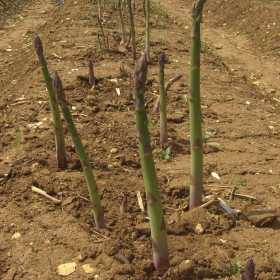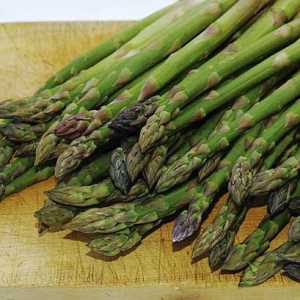How to Grow Asparagus – A Guide to Growing Asparagus
A guide to methods of growing your own asparagus with links to further information on asparagus growing, asparagus seed etc.

New Asparagus Spears in the Bed
Asparagus
Keyfacts on Growing Asparagus:
- Plant Family for Crop Rotation: Asparagaceae
- Growing asparagus is a long term project – it takes at least two years to come into production but will then continue for up to 20 years, repaying the initial investment many times over.
- Asparagus is not suited to either close spacing or container growing.
- You can buy asparagus seed, but it is more usual to cultivate from one-year-old asparagus crowns.
Growing Your Own Asparagus
Asparagus plants are either male or female. The male plants are more productive and all male F1 hybrids are available with their energies going into edible spears rather than berries.
A raised bed is considered the best method of cultivating asparagus. It likes a well-drained, sandy soil, but can be successfully grown on heavier, even clay soils providing they have been cultivated first with plenty of humus and some grit or sand to aid drainage.
In April, plant the crowns 20 cm (8 inches) deep, 30–45 cm (12–18 inches) apart, into a trench 30 cm (12 inch) wide. In a standard raised bed (1.2 metres/4 feet wide), dig the trench in the centre of the bed and make it slightly mounded, so that the roots will slope downwards and out.
Cover the crowns with fine sieved soil to about 5 cm (2 inches) above the top of the crown. Fill to the surface as the plant grows.
Keep weed-free but be careful not to damage the shallow roots as you do so: best to hand-weed. Water as required, but avoid making the trench too wet.
Don’t take a crop in the first year. The spears will turn into foliage to feed the plants. As the foliage turns yellow in autumn, cut it off 5–10 cm (2–4 inches) above ground level.
In spring, draw up a ridge of soil over the centre of the plants, about 10 cm (4 inches) high. Add a general purpose fertilizer such as fish, blood and bone or Growmore. The spears will start to appear in early May. Take just a few and leave the rest to develop.

Asparagus Spears – Ready to Cook!
Cut the spears with a sharp knife some 7.5cm below the ground when they are about 10cm high above the ground. You can actually buy a special knife, especially shaped for cutting asparagus.
The real season starts in mid-May and runs through June when you must show restraint and stop cutting.
In the second year just take 6 or 8 spears per plant, double that in the third year and expect about 20 to 25 spears per plant for the next 20 years.
Protect from late frosts with fleece.
Harvesting Asparagus
- Do not over crop in the first year as this will give you weakened plants and spindly spears. Remember that asparagus is a long-term investment. Restraint can be hard, but you will see the benefits in later years!
- In the first year, don’t harvest at all. In the second year take just 6–8 spears per plant; double that in the third year. You can expect 20–25 spears per plant per year over the next 20 years or so.
- When the spears are around 10 cm (4 inches) high, harvest by cutting them with a sharp knife about 7.5 cm (3 inches) below the ground.
- The season runs from mid-May to June, when you must stop cutting.
Pests and Problems with Asparagus
- Slugs are the main pest.
- Rust (a fungal disease) can be a problem in wet years. Remove affected shoots if rust appears.
- The asparagus beetle is rarely a problem to home growers. They are small with orange markings on their 7mm long bodies and will attack foliage and spears. Use an approved insecticide.
- The main problem with asparagus is over cropping in the early years causing weakened plants and spindly spears. It is hard, but restraint will pay you back.
Varieties of Asparagus
- Asparagus plants are either male or female and the male plants are more productive. You can purchase all-male F1 hybrids.
- Gijnlim is an RHS Award of Garden Merit winner. It is an early variety, providing spears from mid to late April through to the end of June.
- Stewarts Green is a purple variety, sweeter than the green ones, and with less fibre.



